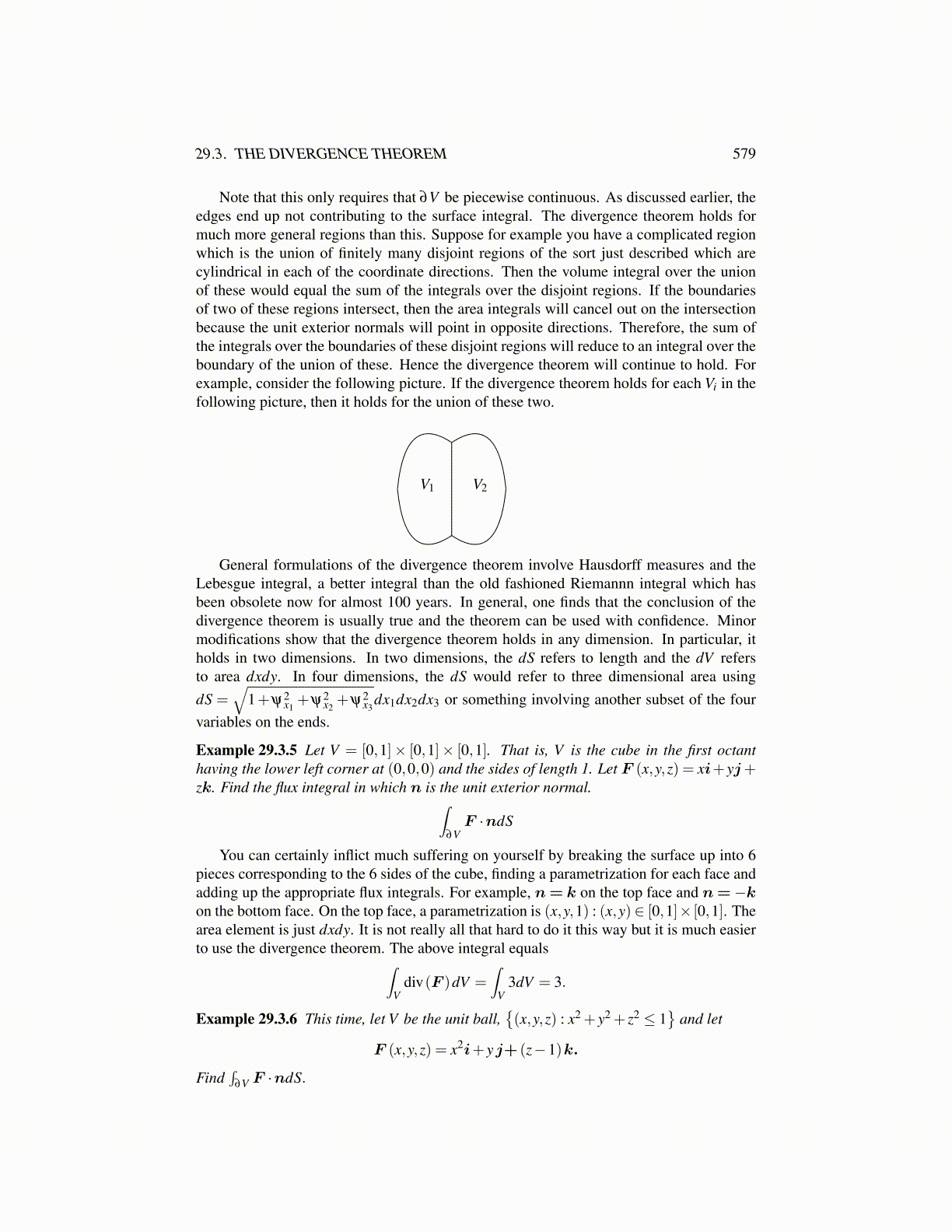
29.4. APPLICATIONS OF THE DIVERGENCE THEOREM 579
chemical reaction taking place. Then the divergence theorem can be used to verify thefollowing equation for u. Such an equation is called a reaction diffusion equation.
∂
∂ t(ρ (x, t)c(x, t)u(x, t)) = ∇ · (k (u,x, t)∇u(x, t))+ f (x,u, t) . (29.6)
Take an arbitrary V for which the divergence theorem holds. Then the time rate ofchange of the heat in V is
ddt
∫V
ρ (x, t)c(x, t)u(x, t) dV =∫
V
∂ (ρ (x, t)c(x, t)u(x, t))∂ t
dV
where, as in the preceding example, this is a physical derivation so the consideration ofhard mathematics is not necessary. Therefore, from the Fourier law of heat conduction,ddt∫
V ρ (x, t)c(x, t)u(x, t) dV =
∫V
∂ (ρ (x, t)c(x, t)u(x, t))∂ t
dV =
rate at which heat enters︷ ︸︸ ︷∫∂V
−J ·ndA +∫
Vf (x,u, t) dV
=∫
∂Vk∇(u) ·ndA+
∫V
f (x,u, t) dV =∫
V(∇ · (k∇(u))+ f ) dV.
Since this holds for every sample volume V it must be the case that the above reactiondiffusion equation 29.6 holds. Note that more interesting equations can be obtained byletting more of the quantities in the equation depend on temperature. However, the aboveis a fairly hard equation and people usually assume the coefficient of thermal conductivitydepends only on x and that the reaction term f depends only on x and t and that ρ and care constant. Then it reduces to the much easier equation
∂
∂ tu(x, t) =
1ρc
∇ · (k (x)∇u(x, t))+ f (x,t) . (29.7)
This is often referred to as the heat equation. Sometimes there are modifications of thisin which k is not just a scalar but a matrix to account for different heat flow propertiesin different directions. However, they are not much harder than the above. The majormathematical difficulties result from allowing k to depend on temperature.
It is known that the heat equation is not correct even if the thermal conductivity did notdepend on u because it implies infinite speed of propagation of heat. However, this doesnot prevent people from using it.
29.4.4 Balance of MassLet y be a point in three dimensional space and let (y1,y2,y3) be Cartesian coordinates ofthis point. Let V be a region in three dimensional space and suppose a fluid having densityρ (y, t) and velocity, v (y, t) is flowing through this region. Then the mass of fluid leavingV per unit time is given by the area integral
∫∂V ρ (y, t)v (y, t) ·ndA while the total mass
of the fluid enclosed in V at a given time is∫
V ρ (y, t) dV . Also suppose mass originates atthe rate f (y, t) per cubic unit per unit time within this fluid. Then the conclusion which canbe drawn through the use of the divergence theorem is the following fundamental equationknown as the mass balance equation.
∂ρ
∂ t+∇ · (ρv) = f (y, t) (29.8)